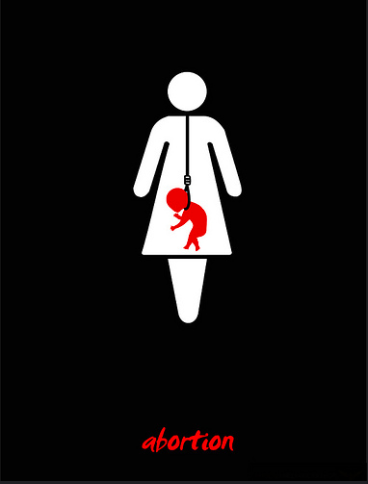Everything You Didn’t Know About Abortion and Jane Roe

A pro-life graphic depicts a pregnant woman with a strangled fetus in her womb. Pro-life ideologies often stem from religious beliefs or ideals of human life starting at conception. Many people who identify as Republican are oftentimes pro-life. Photo by Alex Ribeiro (CC BY-SA 2.0)
March 29, 2019
Pro-choice. Pro-life.
Polar opposite opinions, lines drawn in the sand because of the landmark Supreme Court ruling in Roe v Wade in 1973. After a Texas law banning abortions was challenged by a woman, using the alias Jane Roe, was taken to the highest court of American government, standards for women’s rights were revolutionarily uprooted.
The significance in Roe’s ruling continues to roar through the United States, rising above in a collective cry of women calling out for their due rights. It’s one of the most vital movements in modern American culture, flying under the name of the “Women’s Rights Movement.” This national organization and culture march for equal pay, the right to be safe, equal protection in the courts of the federal government, as well as in the workplace, home, and the streets, and the right to choose what to do with their own bodies without fear of persecution or backlash.
But what most people don’t know about the Women’s Rights Movements is the fight for gender equality wasn’t always such an uphill battle.
Let’s Take A Look Back: Ancient Relevance
Abortion has always been a debated topic, with important texts like the Bible avoiding it and with a very little recorded history of how a woman’s choice has been respected or disregarded. One of the earliest regulations on women and abortions was the ancient 11th century BCE Code of Assura banning women from aborting without their husbands’ permission. The Ancient Egyptians’ have one of the first neutral descriptions of the actual act of performing an abortion on papyrus from 1550 BCE. Even Aristotle made a comment about abortion in his native country of Greece, “[T]he line between lawful and unlawful abortion will be marked by the fact of having sensation and being alive.” This refers to his ideology that the human embryo developed at 40 days if male and 90 days if female, originally being a vegetable or animal soul. Abortion was a crime in Athens against the husband, if his wife was pregnant when he died since his unborn child could have claimed the estate, so it was unusual of Aristotle to develop this viewpoint in his own time while modern times call for this type of attitude towards women’s freedom of choice.
The Beginning of the End
Before the passing of Lord Ellenborough’s Act of 1803, or the Malicious Shooting and Stabbing Act, women and their freedom of choice went hand in hand. Only when the woman experienced “quickening,” the perceived movement of the fetus in the womb, was abortion outlawed and women were trusted with their accounts of when quickening did or did not occur. Midwives and unlicensed village doctors provided abortions with many things such as abortifacients like the extinct silphium or pennyroyal as well as laying on a heated coconut shell, manual labor, and other classically bizarre home remedies to induce miscarriages.
Lord Ellenborough’s Act of 1803 changed all this.
Created by physicians who sought to ensure that the well-being of all humans was ensured, the law was a rambling legislature claiming that no person could be attacked, even if there was no intent to kill or death did not result. Unborn children were added to that list, developing a severe set of restrictions on abortion and the unlicensed practice of common village midwives and herbalists. This was the first in a long line of tight regulations on women’s liberty to reinstate their period.
Pilgrims Brought More Than Smallpox to America
While women had freedom of choice after migration to the United States seeking religious emancipation, that quickly changed, and suddenly women faced the same management laws they did back in England. A long and quiet fight ensued, all boiling to a point in Roe v Wade.
To know the irony and true duality of Roe, Jane Roe, the plaintiff in the landmark case, has to be understood to the best of an outsider’s limited capacity.
Jane Roe was an alias for Norma McCorvey. As is detailed in CTHSToday.org’s reporter Zoe Vescera’s story about the modern relevance of McCorvey’s long road to the Supreme Court, McCorvey had fallen pregnant for a third time and was emotionally and financially not prepared to raise a baby, considering she had signed her first child over to her mother and then given her second kid up for adoption. She attempted to get an abortion but was blocked by Texas’s statute stating that abortion could only be obtained in instances of rape, incest, or legitimate health concerns for the woman. She took her case all the way to the United States Supreme Court with the help of her lawyers, Sarah Weddington, Gloria Allred, and Linda Coffee, and won her plea in front of esteemed justices, gaining privacy rights for women nationwide. Forty-eight states had to make changes to their state abortion laws as a result of the ruling in Roe.
Before All That
Norma McCorvey was a child damaged by years of traveling around, parental strife, and rape at the hands of her mother’s cousin, who denied all of McCorvey’s claims against him. She was raised briefly by a violently alcoholic mother and found herself married at 16 to the father of her first child Melissa. She moved in with her mother and gave birth to Melissa, becoming an alcoholic and identifying as a lesbian soon after. McCorvey’s mother tricked her into signing Melissa away and then subsequently kicked her out of the house.
McCorvey wandered for a year, getting pregnant again and giving the child up for adoption. At this point, she moved to Dallas, TX, and became with child again, this time seeking an abortion. Under the urging of friends, she attempted to claim she was raped, but due to a lack of physical or written evidence, the claim fell through. It was at this time that she was referred to Coffee and Weddington, two lawyers who were looking for a pregnant woman seeking an abortion in order to form a case against Texas’s restrictive statute. McCorvey later admitted to feeling like a pawn in Coffee and Weddington’s scheme to challenge the state government.
The Big Day
January 22, 1973.
The date the Supreme Court handed down the decision that a woman’s right to privacy was protected by the Fourteenth Amendment and strengthened in Griswold v Connecticut.
After the ruling of Roe, McCorvey was working at an abortion clinic when something life-changing happened to her. “I looked at a fetal development chart at the Operation Rescue Office in Dallas. I had a lot of emotions stirring up inside of me. That’s when I decided that it was wrong in any stage of pregnancy,” said McCorvey in her second novel, Won By Love. The novel details her ideological shift from being pro-choice to being religiously pro-life. She was baptized by a local evangelical minister in the backyard pool of a Dallas neighbor and later announced her induction into the Catholic Church as a full-fledged member. She renounced her position in Roe by declaring her support for Republican presidential candidate Ron Paul in 2008.”I support Ron Paul for president because we share the same goal, that of overturning Roe v. Wade. He has never wavered on the issue of being pro-life and has a voting record to prove it. He understands the importance of civil liberties for all, including the unborn,” said McCorvey of her change in heart.
Coming Full Circle
If Jane Roe’s own shift in beliefs doesn’t describe the charged and highly political composition of Roe v Wade, there is very little else that does. From being a free-spirited lesbian to a conservative Catholic, McCorvey experienced many slices of life to add to the complete complexity of the nature of women and their bodies in a global society.



